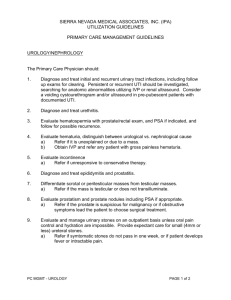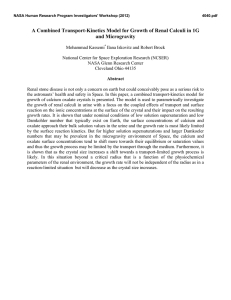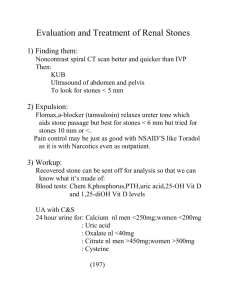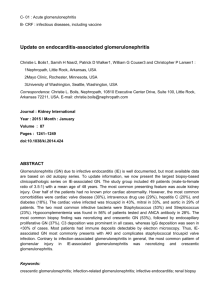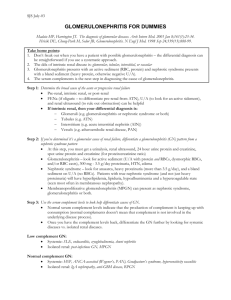hematuria
advertisement
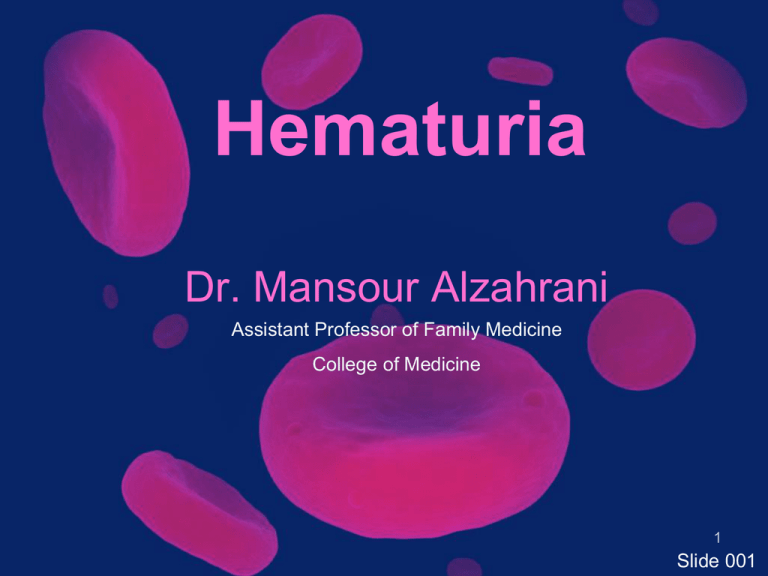
Hematuria Dr. Mansour Alzahrani Assistant Professor of Family Medicine College of Medicine 1 Slide 001 What is the definition of hematuria? 2 The Correct Answer American Urological Association (AUA) definition - ≥ 3 intact red blood cells visible per high-powered field (RBC/HPF) on microscopic exam of urine sediment from 2 of 3 properly collected urine specimens. 3 Take more details • Gross vs microscopic • Symptomatic vs Asymptomatic • Transient vs Persistent 4 Question Where are the blood came from (source)? 5 6 Acute Glomerulonephritis Background: Glomerulonephritis is defined here as a disease characterized by intraglomerular inflammation and cellular proliferation associated with hematuria. 7 • Hematuria in patients with glomerulonephritis is typified by the presence of dysmorphic red cells or red-cell casts in the urine, findings that differentiate hematuria of glomerular origin from extraglomerular bleeding. 8 • Acute glomerulonephritis is a syndrome characterized by the abrupt onset of macroscopic hematuria; oliguria; acute renal failure 9 Acute Glomerulonephritis • Currently described as a clinical syndrome that frequently manifests as a sudden onset of hematuria, proteinuria, and red cell casts. • This clinical picture often is accompanied by hypertension, edema, and impaired renal function( sudden GFR, HTN, Edema). 10 Pathophysiology • Glomerular lesions in acute glomerulonephritis are the result of glomerular deposition or in situ formation of immune complexes. On gross appearance, the kidneys may be enlarged up to 50%. • Histopathologic changes include swelling of the glomerular tufts (network) and infiltration with polymorphonucleocyte. Immunofluorescence reveals deposition of immunoglobulins and complement. 11 12 13 Frequency • In the US, glomerulonephritis represents 10-15% of glomerular diseases. Variable incidence has been reported due in part to the subclinical nature of the disease in more than one half the affected population. • Remains much more common in regions such as Africa, the Caribbean, India, Pakistan, Malaysia, Papua New Guinea, and South America. 14 Mortality/Morbidity, Sex, Age • Most epidemic cases follow a course ending in complete patient recovery • Sporadic cases often progress to a chronic form. • The mortality rate of acute glomerulonephritis in the most commonly affected age group, pediatric patients, has been reported at 0-7%. • A male-to-female ratio of 2:1 has been reported. • Most cases occur in patients aged 5-15 years. • Only 10% occur in patients older than 40 years. • Acute nephritis may occur at any age, including infancy. 15 Clinical • History – suddenly onset of puffiness of the eyelids, facial edema and dark and scanty urine; with the elevated blood pressure. – Nonspecific symptoms include weakness, fever, abdominal pain, and malaise. – In the setting of postinfectious acute nephritis, a latent period of up to 3 weeks occurs before onset of symptoms. – The latent period generally is 1-2 weeks for the postpharyngitis form of the disease and 2-4 weeks in the case of postdermal infection. – Onset of nephritis within 1-4 days of streptococcal infection suggests preexisting renal disease. 16 Physical • Edema, frequently including the face, specifically the periorbital area • Hypertension in as many as 80% of patients in all populations affected • Gross hematuria • Skin rashes • Abnormal neurologic examination or altered level of consciousness • Hypocomplementemia • Pharyngitis 17 Causes • Postinfectious etiologies – The most common cause is postinfectious Streptococcus species (ie, group A, beta-hemolytic). Two types have been described: 1. attributed to serotype 12, poststreptococcal nephritis due to an upper respiratory infection occurring primarily in the winter months, and 2. attributed to serotype 49, poststreptococcal nephritis due to a skin infection 18 Causes – Other specific agents include viruses and parasites, systemic and renal disease, visceral abscesses, endocarditis, infected grafts or shunts, and pneumonia. – Bacterial causes other than group A streptococci may be diplococcal, streptococcal, staphylococcal, or mycobacterial. Salmonella typhosa, Brucella suis, Treponema pallidum, Corynebacterium bovis, and actinobacilli also have been identified 19 Causes • Viral: Cytomegalovirus, coxsackievirus, EpsteinBarr virus, hepatitis B, rubella, rickettsial scrub typhus, and mumps are accepted as viral causes* • Fungal and parasitic: Identified organisms include Coccidioides immitis and the following parasites: Plasmodium malariae, Plasmodium falciparum, Schistosoma mansoni, Toxoplasma gondii, filariasis, trichinosis, and trypanosomes.* * only if it can be documented that a recent group A beta-hemolytic streptococcal infection did not occur. 20 Systemic causes • Wegener granulomatosis causes glomerulonephritis that combines upper and lower granulomatous nephritises. • Hypersensitivity vasculitis encompasses a heterogeneous group of disorders featuring small vessel and skin disease. • Cryoglobulinemia causes abnormal quantities of cryoglobulin in plasma that result in repeated episodes of widespread purpura and cutaneous ulcerations upon crystallization. • Systemic lupus erythematosus causes glomerulonephritis through renal deposition of immune complexes. 21 Systemic causes • Polyarteritis nodosa causes nephritis from a vasculitis involving the renal arteries. • Henoch-Schönlein purpura causes a generalized vasculitis resulting in glomerulonephritis. • Goodpasture syndrome causes circulating antibodies to type IV collagen and often results in a rapidly progressive oliguric renal failure (weeks to months). 22 Renal diseases • Membranoproliferative glomerulonephritis is due to the expansion and proliferation of mesangial cells as a consequence of the deposition of complements. – Type I refers to the granular deposition of C3; – Type II refers to an irregular process. • Berger disease (IgG-immunoglobulin A [IgA] nephropathy) glomerulonephritis results from a diffuse mesangial deposition of IgA and IgG. 23 Renal diseases • Idiopathic rapidly progressive glomerulonephritis is a form of glomerulonephritis characterized by the presence of glomerular crescents. Three types have been distinguished. Type I is an antiglomerular basement membrane disease, type II is mediated by immune complexes, and type III is identified by antineutrophil cytoplasmic antibody. 24 Lab Studies • Complete blood count – CBC may demonstrate dilutional anemia. – In a setting of infectious etiology, pleocytosis may be evident. • Electrolytes including BUN and creatinine: BUN and creatinine exhibit a degree of renal compromise. • Urinalysis – – – – Urine is dark. Specific gravity is greater than 1020 osm. Proteinuria is indicated. RBCs and red cell casts are present. 25 Lab Studies • Antistreptolysin O – This quantitative titer is increased in 60-80% of patients. – Increase begins in 1-3 weeks, peaks in 3-5 weeks, and returns to normal in 6 months. – Unrelated to severity, duration, or prognosis of renal disease. 26 Lab Studies • Serum complement (C3, C4) – Low serum complement levels suggest the following systemic diseases: cryoglobulinemia, systemic lupus erythematosus, bacterial endocarditis, & shunt nephritis. – Under the same conditions, renal diseases characteristic of membranoproliferative or poststreptococcal glomerulonephritis also may be considered. – Normal serum complement levels suggest a visceral abscess, polyarteritis nodosa, Goodpasture syndrome, or Henoch-Schönlein purpura. In addition, normal complement levels suggest renal diseases such as immune complex disease, idiopathic rapidly progressive glomerulonephritis, and IgG or IgA nephropathy. 27 Lab Studies • Renal biopsy – Acute glomerulonephritis usually has a selflimited course with a good prognosis. – Candidates for biopsy are patients with an individual or family history of renal disease and patients with atypical presentation, including massive proteinuria, nephrotic syndrome, or a rapid rise in creatinine without resolution 28 Therapeutics • Consider admission for patients with the following conditions: – Compromised renal function or immunosuppression. – Anuria, nephrotic syndrome, massive proteinuria, significant hypertension, or pulmonary symptoms. – Oliguria and renal failure. – Severe hypertension associated with signs of cerebral dysfunction is a hypertensive emergency requiring immediate aggressive treatment. 29 Therapeutics • Poststreptococcal – Eradicate streptococcal causes by oral antibiotic therapy. • Restrict fluids for acute nephritic syndrome • Hypertension – Use anti HTN medications. 30 Therapeutics • Nonstreptococcal glomerulonephritis: Steroids and cytotoxic agents may be indicated in the following conditions: – Glomerulonephritis secondary to hypersensitivity – Vasculitis 31 Therapeutics (Nonstreptococcal glomerulonephritis) • Systemic lupus erythematosus: Pulse therapy with methylprednisolone • Systemic lupus erythematosus: Pulse therapy with methylprednisolone • Idiopathic rapidly progressive glomerulonephritis: Pulse intravenous methylprednisolone is used to reduce risk of progression to end-stage renal disease. Cyclophosphamide also is used in conjunction with steroids. • Goodpasture syndrome: Plasmapheresis is combined with immunosuppression. High-dose pulse steroids are effective for pulmonary hemorrhage. 32 Complications • 0.5-2% of patients with acute glomerulonephritis progresses toward renal failure, resulting in kidney death in a short period. • Abnormal urinalysis may persist for years (microhematuria). • Marked decline in glomerular filtration rate is rare. • Other complications, include the following: – – – – – Hypertensive retinopathy Hypertensive encephalopathy Rapidly progressive glomerulonephritis Chronic renal failure Nephrotic syndrome 33 Prognosis • In poststreptococcal nephritis, long-term prognosis generally is good. > 98% of individuals are asymptomatic after 5 years, with chronic renal failure 1-3% of the time. • The prognosis for nonstreptococcal postinfectious glomerulonephritis depends on the underlying agent, which must be identified and addressed. • Other causes of acute glomerulonephritis have outcomes varying from complete recovery to complete renal failure. Prognosis depends on the underlying disease and the overall health of the patient. • Occurrence of cardiopulmonary or neurologic complications worsens the prognosis. 34 35 Kidney stones • Also known as nephrolithiasis, urolithiasis or renal calculi. • Solid concretions ( crystal aggregations) of dissolved minerals in urine • found inside the kidneys or ureters. They vary in size from as small as a grain of sand to as large as a grapefruit 36 Cont. • Kidney stones (calculi) are hardened mineral deposits that form in the kidney. They originate as microscopic particles and develop into stones over time. The medical term for this condition is nephrolithiasis, or renal stone disease. 37 Location of Renal stones 38 • A vast majority of stones will contain elements of calcium within them and therefore are easily seen on x-ray having the same density as bone. • Depending on the size, number, and the location of the stone(s) as well as it's composition guides initial and then further management can be implemented. 39 40 Renal stones • Kidney stones occur in 1 in 20 people at some time in their life. • Urolithiasis is rare in children. When present, it is often associated with specific metabolic disorders or anatomic abnormalities . • For precipitation of crystals in urine to occur, the urine must be "supersaturated" for the precipitating crystal. 41 Stone Formation • • • Kidney stones form when there is a high level of mineral (s) ; i.e. calcium (hypercalciuria), oxalate (hyperoxaluria), or uric acid (hyperuricosuria) in the urine; a lack of citrate in the urine; or insufficient water in the kidneys to dissolve waste products. Urine normally contains chemicals—citrate, magnesium, pyrophosphate—that prevent the formation of crystals. 42 Cont. • Low levels of these inhibitors can contribute to the formation of kidney stones. • Citrate is thought to be the most important • The chemical composition of stones depends on the chemical imbalance in the urine. 43 Types of renal stones 1. 2. 3. 4. Calcium oxalate Phosphate Uric acid Cystine 44 Calcium Stones: • Approximately 85% of stones are composed predominantly of calcium compounds. • The most common cause of calcium stone production is excess calcium in the urine (hypercalciuria). • In hypercalciuria, excess calcium builds up in the kidneys and urine, where it combines with other waste products to form stones. • Low levels of citrate, high levels of oxalate and uric acid, and inadequate urinary volume may also cause calcium stone formation. 45 Cont. • Calcium stones are composed of oxalate (calcium oxalate) or phosphate (calcium phosphate). • Calcium phosphate stones typically occur in patients with metabolic or hormonal disorders such as hyperparathyroidism and renal tubular acidosis. • These stones come in 2 different types - monohydrate and dihydrate. • Calcium oxalate dihydrate stones usually break easily with lithotripsy. • Monohydrate stones are among the most difficult stones to fragment. 46 Calcium oxalate monohydrates Calcium oxalate dihydrates 47 Uric Acid Stones • Digestion produces uric acid. • If the acid level in the urine is high or too much acid is excreted, the uric acid may not dissolve and uric acid stones may form. • They are not visible on X-rays. • Patients with gout often develop these stones. • Uric acid stones form in acidic urine and often dissolve when the urine is alkalinized. 48 Cont. • Genetics may play a role in the development of uric acid stones, which are more common in men. • Approximately 10% of patients with kidney stone disease develop this type of stone. 49 Uric acid 50 Aetiopathogenesis • • • • • • • Infections Hot climate Dietary factors Metabolic factors Immobilization Decreased urinary citrate Inadequate urinary drainage 51 Staghorn Calculus 52 Clinical Features • • • • • Renal pain Ureteric colic Haematuria Recurrent UTI Guarding and Rigidity 53 54 Complications 1. Calculus hydronephrosis 2. Calculus pyonephrosis 3. Renal failure 4. Squamous cell carcinoma 55 Investigations 1. Blood urea and creatinine 2. Plain x-ray 3. IVP 4. Urine 56 X-ray renal stone 57 Intravenous Pyelogram 58 Treatment A. Non-operative • Conservative • ESWL B. Operative • Endoscopy • Open surgery 59 60 ESWL Machine 61 Renal endoscope 62 63 64
